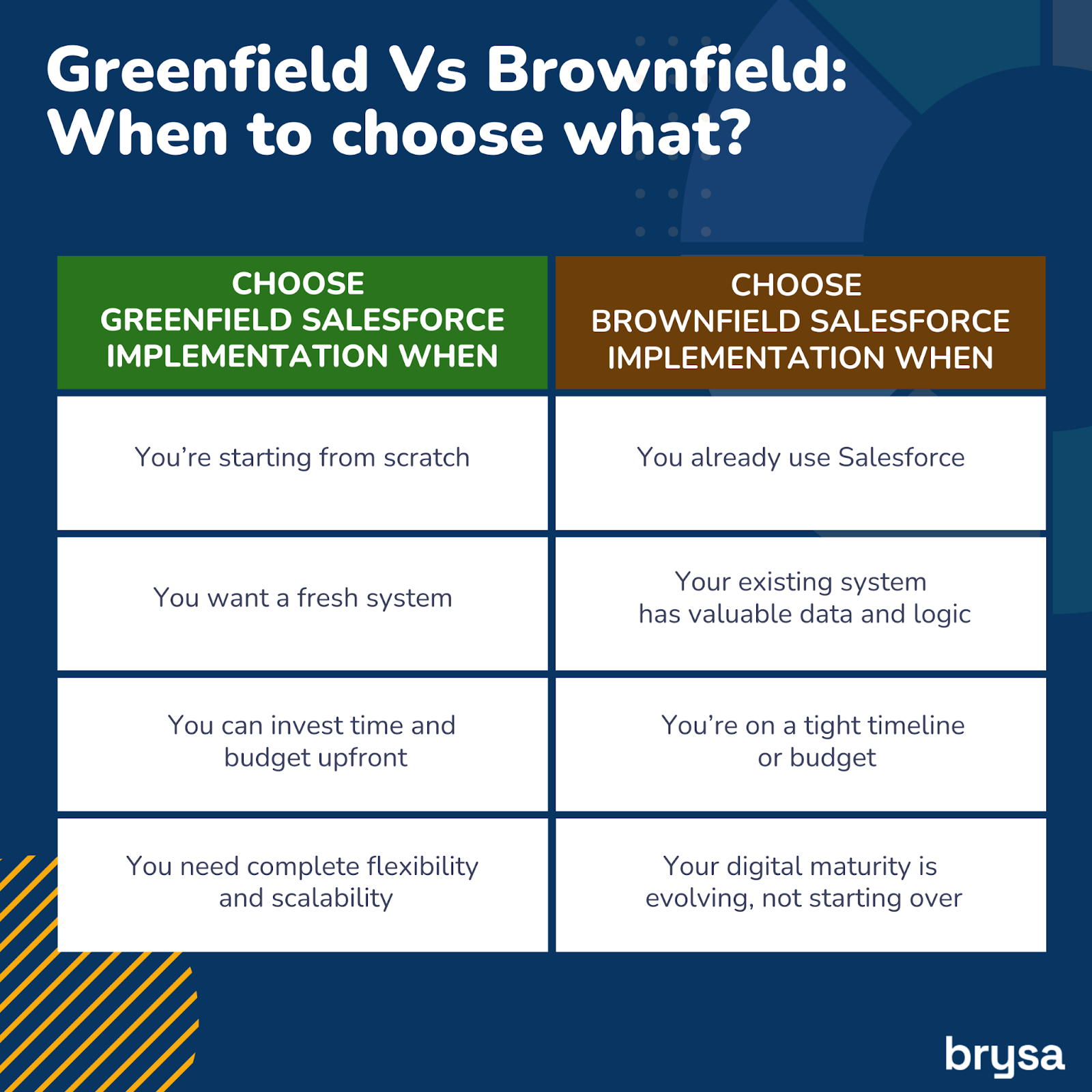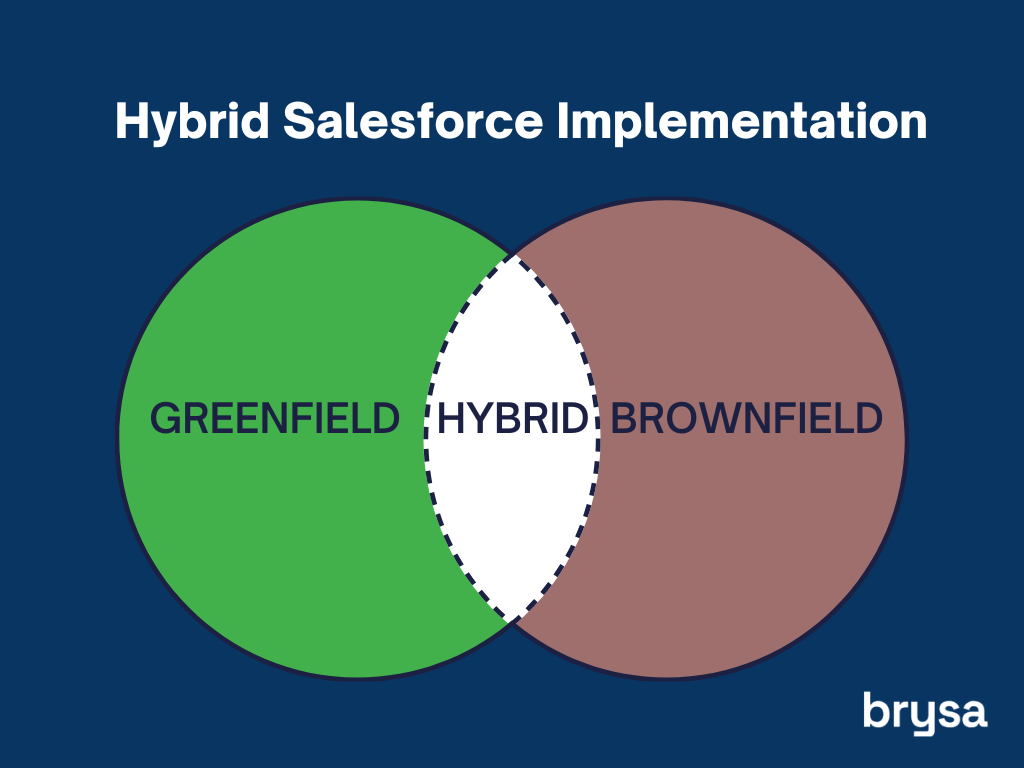One size doesn’t work for all. This is particularly true when it comes to Salesforce implementations. However, choosing the right path that aligns with your digital maturity is not easy. While some of you might crave a clean slate, others need to build on what’s already there. In the world of Salesforce, this decision can make or break your success. So, how do you know which direction to take? Let’s unpack brownfield vs greenfield implementation, the two most common (and often misunderstood) implementation strategies.
What Is Greenfield Implementation in Salesforce?
It is the implementation of Salesforce in an entirely new environment. The organisation implementing it has no pre-existing systems or procedures. In other words, there is a blank canvas for you to customise or set up Salesforce in any way you want, as there are no legacy constraints in it.
A great example of greenfield Salesforce implementation would be a newfound startup wanting to implement Salesforce Sales Cloud to manage its lead pipeline.
What Is Brownfield Implementation in Salesforce?
As you would have guessed, a brownfield implementation is the opposite of a greenfield implementation. This involves working within an existing Salesforce setup to enhance or upgrade the current system. So instead of starting from zero or a blank canvas, you improve or extend what’s already in place through brownfield implementation.
A great example of this would be a business using an on-premise ERP wanting to integrate it with Salesforce. Their goal is to unite customer service and sales data for more informed decision-making.
Differences Between Greenfield and Brownfield Implementation in Salesforce
The most obvious difference between the two is their starting point. While Greenfield begins with a blank slate, Brownfield implementation works within an existing framework. This fundamental distinction shapes how each model impacts a variety of factors.
A Greenfield implementation is ideal for businesses:
- Looking to reimagine their processes
- Adopt modern best practices
- Build a CRM system aligned with new business models.
Brownfield is better suited for organisations that want to:
- Preserve valuable historical data
- Leverage existing investments
- Improve specific parts of their Salesforce ecosystem without a full overhaul.
Understanding this distinction is essential before deciding which path offers the best value and alignment with long-term goals.
Here is a quick summary of all the differences between these two types of implementation:
| Aspect | Greenfield Implementation | Brownfield Implementation |
| Scope | Full-scale setup from scratch with no legacy constraints. | Enhancements or integrations within an existing Salesforce or IT environment. |
| Flexibility | High flexibility to design systems and processes tailored to current business goals. | Limited by existing configurations, customisations, and data structures. |
| Time | Typically takes longer due to planning, configuration, and initial data setup. | Faster if changes are incremental, though complex integrations may still add time. |
| Cost | Potentially higher upfront cost due to complete implementation from zero. | Lower initial costs, but could increase based on cleanup or integration needs. |
| Integration Complexity | Simpler, as it’s usually a fresh start without legacy system constraints. | High complexity due to the need to integrate with existing systems like ERP, databases, etc. |
| Business Agility | Offers greater agility and future scalability due to clean architecture. | May face limitations in agility due to technical debt and legacy system dependencies. |
How Are Greenfield and Brownfield Similar?
Despite the many differences, Greenfield and Brownfield Salesforce implementations share many similarities, too.
For starters, both demand careful planning and strategic alignment. It doesn’t matter whether you’re setting up a new Salesforce project or enhancing an existing one; you must get your basics right. All the usual rules apply – defining business objectives, understanding user needs, creating a clear roadmap, monitoring performance, etc.
They also share a similar challenge – driving user adoption. Whether your employees are interacting with Salesforce for the first time or adapting to an updated version, successful implementations depend on how well and fast your people accept the change.
Thirdly, both setups require customisation to fit specific business workflows. Only then will the solution be functional and successful.
Finally, expert execution, whether through internal teams or Salesforce experts, is necessary in both cases. Only then will you be able to avoid common pitfalls and arrive at a solution that is optimised for future growth.
When to Choose Greenfield Over Brownfield – And Vice Versa
If you are still unsure whether to go for a Greenfield or Brownfield Salesforce implementation, use the framework below to arrive at a decision.
Choose Greenfield If…
- You’re starting from scratch: You’re a startup with no existing CRM, OR you own a highly fragmented system that is of no use anymore.
- You want a fresh system: You’re looking to embrace modern best practices, OR you want to eliminate your legacy baggage.
- You can invest time and budget upfront: You’re willing to commit the resources needed to roll out a completely new Salesforce environment.
- You need complete flexibility and scalability: You want to avoid limitations from existing systems, OR you want to build a platform tailored exactly to your evolving needs.
Choose Brownfield If…
- You already use Salesforce: You have a working Salesforce CRM and want to enhance rather than replace.
- You’re on a tight timeline or budget: You need results fast. OR you can’t afford a full-scale rebuild right now.
- Your existing system has valuable data and logic: You want to preserve what works for you, like historical data and compliance-ready configurations.
- Your digital maturity is evolving, not starting over: You’re modernising in phases, OR you want to balance innovation with continuity.
The Hybrid Salesforce Implementation Approach (The Overlooked Middle Path)
Not every organisation fits neatly into a Greenfield or Brownfield box. Some of them even need a hybrid Salesforce implementation. It is essentially a balanced middle path. It blends the freedom of new Salesforce capabilities with the practicality of leveraging existing systems. It’s especially useful for companies in transition.
In a hybrid setup, you can retain valuable parts of your current infrastructure. For instance, you can retain your legacy ERP systems and at the same time adopt a newer Salesforce module like Service Cloud. This allows your teams to phase their transformation. It will also reduce disruption and help your team gradually shift toward a more agile, cloud-based future.
The benefits of this are multifold. You get access to AI-driven insights and advanced automation, all while maintaining operational continuity. In essence, a hybrid implementation is a low-risk path toward full digital maturity.
Common Mistakes to Avoid in Both Implementation Types
Whether you opt for a Greenfield or Brownfield Salesforce implementation, avoiding these common mistakes will help ensure long-term success and adoption:
- Poor Data Migration: Businesses often end up migrating messy and irrelevant data. This is often caused by importing data from spreadsheets or legacy CRMs and failing to clean and validate data.
How to avoid: Always audit your data beforehand. Migrate only what’s absolutely necessary.
- Over-Customisation: Going overboard in customisation can often backfire. Businesses often add too many custom fields and automation rules without a well-thought-out strategy. This creates technical debt and makes the system harder to maintain.
How to avoid: Stick to standard Salesforce functionality wherever possible. Introduce customisations gradually.
- Skipping Change Management: If stakeholders and end users aren’t kept in the loop or shown the value of the new system, adoption suffers.
How to avoid: Communicating the why behind the implementation. Involve key users early in the process. This can reduce resistance.
- Underestimating User Training: Businesses often think that teams will “figure it out” on their own. Without proper training tailored to user roles, productivity drops and errors increase.
How to avoid: Invest in structured onboarding and learning resources. This will improve user confidence and performance.
- Neglecting Post-Implementation Support: Many teams treat go-live as the finish line. In reality, it’s just the beginning. Without dedicated post-implementation support, your project will overflow with unresolved bugs and missed optimisation opportunities.
How to avoid: Establish a support plan and gather feedback regularly. Continuously refine the system.
How Can Brysa Help with Both Greenfield and Brownfield Implementations?
As the UK’s leading Salesforce consultant, Brysa expertly handles both Greenfield and Brownfield projects through tailored implementation services. For Greenfield projects, we build tailored Salesforce solutions from scratch to match your business goals. In Brownfield setups, we enhance and integrate existing systems for better performance and scalability. With deep expertise and industry know-how, we ensure smooth, strategic Salesforce rollouts, no matter your starting point. Contact us now.



